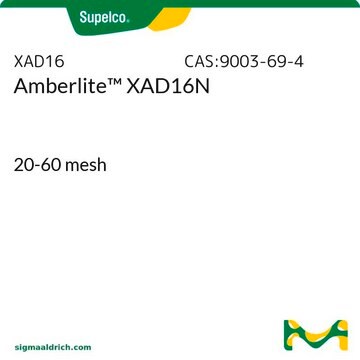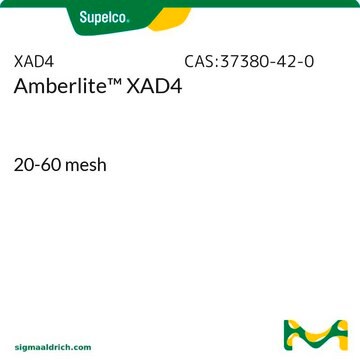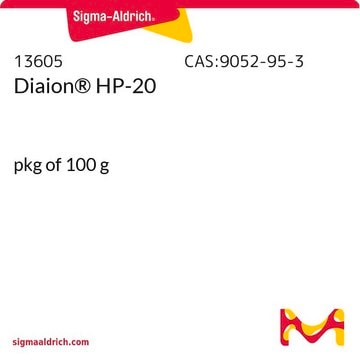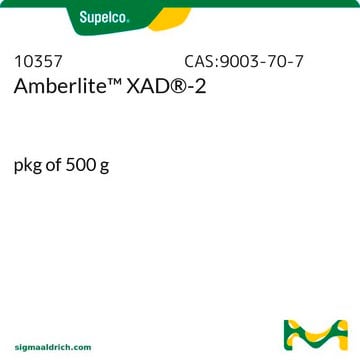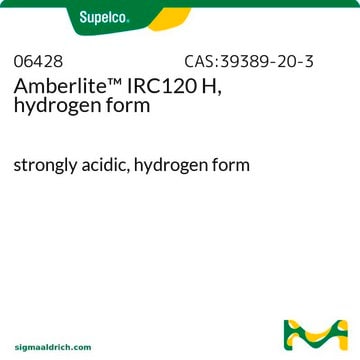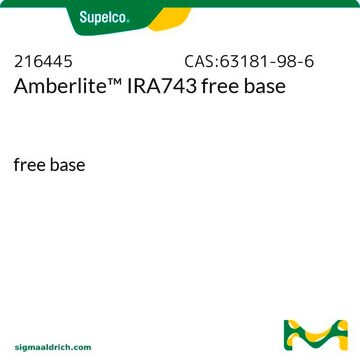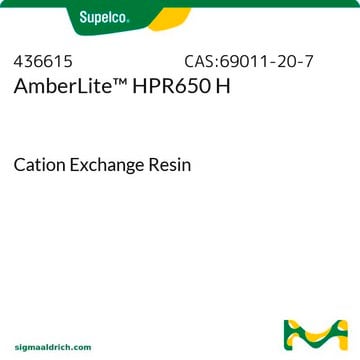573698
Adsorbente polimérico AmberSep® OPTIPORE L-493
20-50 mesh
Iniciar sesiónpara Ver la Fijación de precios por contrato y de la organización
About This Item
Productos recomendados
Nombre del producto
Adsorbente polimérico AmberSep® OPTIPORE L-493,
Formulario
beads
Nivel de calidad
técnicas
LPLC: suitable
superficie
1100 m2/g
Matriz
styrene-divinylbenzene (macroporous)
grupo activo de la matriz
polymer
tamaño de partícula
20-50 mesh
tamaño de poro
1.16 mL/g pore volume
46 Å mean pore size
densidad aparente
680 g/L (19.0 kg/cuft)
técnica de separación
mixed mode
Descripción general
AmberSep® OPTIPORE L-493 is a polymeric adsorbent developed for the concentration of organic compounds from air and water. It is a highly cross-linked styrenic polymer that is insoluble in strong acids, strong bases, and organic solvents. It has a unique pore size distribution and high surface area. It is a wet material intended for liquid applications and can be easily dried in a flowing stream of ambient temperature air. The adsorbent possesses a hydrophobic surface and has non-catalytic nature.
Aplicación
Dow ha desarrollado este adsorbente para la concentración de compuestos orgánicos del agua.
Las principales características de este adsorbente son:
¿ Matriz de polímero altamente reticulado
¿ Distribución de tamaño de poro única
¿ Elevada superficie
¿ Capacidad mejorada para compuestos orgánicos
¿ Superficie de adsorbente hidrófobo
¿ Actividad no catalítica
¿ Lechos esféricos con buena resistencia física.
Las principales características de este adsorbente son:
¿ Matriz de polímero altamente reticulado
¿ Distribución de tamaño de poro única
¿ Elevada superficie
¿ Capacidad mejorada para compuestos orgánicos
¿ Superficie de adsorbente hidrófobo
¿ Actividad no catalítica
¿ Lechos esféricos con buena resistencia física.
AmberSep® OPTIPORE L-493 Polymeric Adsorbent may be used in the:
- Solid phase extraction of copper, lead, and iron from water and food samples
- Kinetics study to examine the adsorption of acrylonitrile using zero-length columns
- Extraction of desired complex in the evaluation of common laboratory methods for measuring cadmium content using ELECTRE technique
- Comparative study to examine the adsorption behaviors of common polymeric adsorbents in the separation of phenol and BPA
- Study to compare the adsorptive ability of resins in recovering alcohols
- Determination of chromium in contaminated water samples from industries using FI-FAAS
- Separation of acetic acid from volatile fatty acids (VFAs) mixture
Información legal
Ambersep is a registered trademark of DuPont de Nemours, Inc.
Código de clase de almacenamiento
11 - Combustible Solids
Clase de riesgo para el agua (WGK)
WGK 3
Punto de inflamabilidad (°F)
Not applicable
Punto de inflamabilidad (°C)
Not applicable
Equipo de protección personal
Eyeshields, Gloves, type N95 (US)
Elija entre una de las versiones más recientes:
¿Ya tiene este producto?
Encuentre la documentación para los productos que ha comprado recientemente en la Biblioteca de documentos.
Separation of bisphenol A and phenol from water by polymer adsorbents: Equilibrium and kinetics studies
Ipek I, et al.
Journal of Water Process Engineering, 16, 206-211 (2017)
Ranking of cadmium low amount measurement systems according to economic, environmental, and functional indicators using ELECTRE analytical method
Chahkandi B, et al.
Annals of Civil and Environmental Engineering (2021)
Kinetics of acrylonitrile adsorption from an aqueous solution using Dowex Optipore L-493
Wegmann C, et al.
Separation and Purification Technology, 81(3), 429-434 (2011)
Volatile fatty acid adsorption on anion exchange resins: kinetics and selective recovery of acetic acid
Eregowda T, et al.
Separation Science and Technology, 55(8), 1449-1461 (2020)
Adsorptive recovery of alcohols from a model syngas fermentation broth
Sadrimajd P, et al.
Fuel: The Science and Technology of Fuel and Energy, 254, 115590-115590 (2019)
Nuestro equipo de científicos tiene experiencia en todas las áreas de investigación: Ciencias de la vida, Ciencia de los materiales, Síntesis química, Cromatografía, Analítica y muchas otras.
Póngase en contacto con el Servicio técnico
